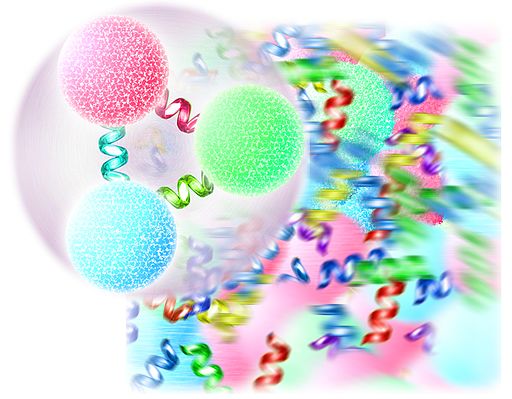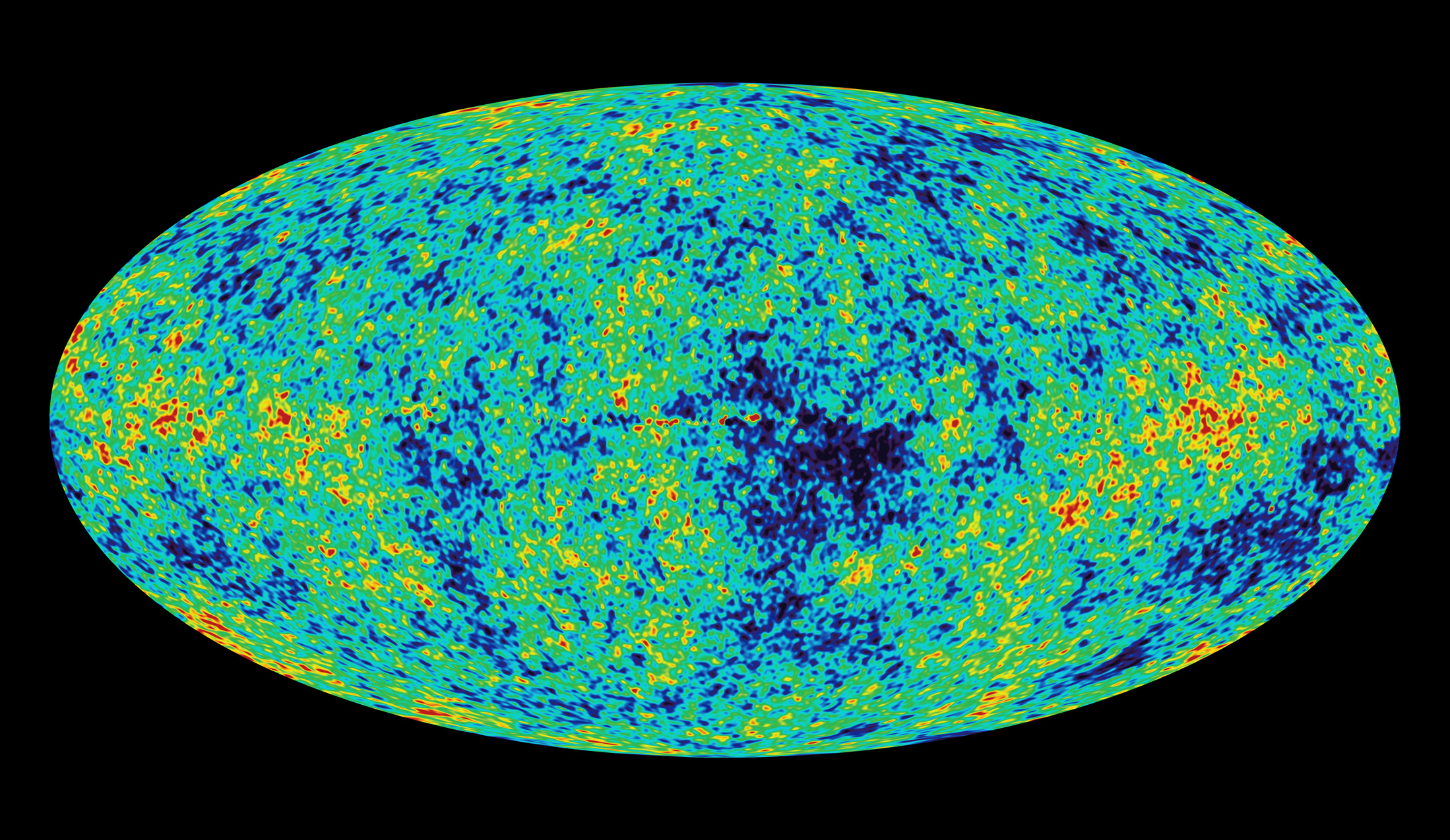2. Of Quarks, Hadrons and Photons (13.8 Ga)
Summary The cooling Universe underwent a series of phase transitions, from a hot quark-gluon plasma after a fraction of a second to neutral hydrogen-helium clouds after 380,000 years. At the latter time the Universe became transparent for light, and the resulting light radiation is today detectable as the Cosmic Microwave Background which impinges Earth from every direction. Since that time hydrogen atoms constitute the majority of the Universe’s visible matter.
Keywords Atoms; Cosmic Microwave Background; Elementary Particles; Nuclear Fusion; Particle Physics

An artist’s impression of a quark-gluon plasma short after the Big Bang. The balls are quarks, a type of elementary particles, and the helixes are gluons, carriers of the strong nuclear interaction. (© User:S13mashina / Wikimedia Commons / CC-BY-SA-4.0)
As the Universe continued to expand and cool down, matter experienced a series of phase transitions. A picosecond (10-12 s) after the Big Bang the Universe was too hot to let quarks condense into larger structures, and so the Universe was filled with a hot quark-gluon plasma. This Quark Epoch came to an end after a millionth of a second (10-6 s), when the quark-gluon plasma condensed into protons and neutrons. A proton consists of two up quarks and one down quark, and a neutron consists of one up quark and two down quarks, being bound together by gluons. While a proton has a positive electric charge, a neutron has no electric charge.
In the then following Hadron Epoch – a hadron is a composite particle with two or more quarks, for example a proton or a neutron – free quarks did not exist anymore, and the Universe was mainly filled up with protons, neutrons, electrons, neutrinos and photons. After one second hadrons were not produced anymore, and most hadrons and anti-hadrons annihilated each other in collisions. In the following Lepton Epoch the Universe expanded and cooled further, until most leptons and anti-leptons annihilated each other after 100 seconds. It is an unsolved miracle why in the turbulent phases after the Big Bang slightly more matter than anti-matter was produced, with one explanation approach being quantum fluctuations.
From about 10 seconds until 20 minutes after the Big Bang, some protons and neutrons underwent nuclear fusion into helium-4 atomic nuclei, which are atomic nuclei with two protons and two neutrons. The remaining protons simply are hydrogen-1 atomic nuclei, while the free neutrons not bound into helium-4 nuclei decayed into other particles. This Big Bang nucleosynthesis led to mass abundances of 75% hydrogen and 25% helium throughout the Universe. These mass abundances can still be seen in many parts of the Universe today. Also small amounts of hydrogen-2, helium-3 and lithium-7 atomic nuclei were produced during the Big Bang nucleosynthesis, but their fractions are negligible.

A temperature map of the Cosmic Microwave Background (CMB). The CMB was released 380,000 years after the Big Bang, today impinges Earth from every direction and was first discovered in 1964. It is shown in an egg shape due to the used map projection from a globe to a plane. (© NASA / Wikimedia Commons / Public Domain)
380,000 years after the Big Bang the Photon Epoch came to an end. The temperature of the Universe was 3000 Kelvin, which is about half the temperatures of Sun’s surface and of Earth’s core. At that time the atomic nuclei and free electrons combined to form electrically neutral atoms. This led to a transparent Universe, as the probability of photons being absorbed was much lower for the now prevailing electrically neutral atoms, if compared to the previously prevailing electrically charged particles. This decoupling of photons from matter led to the Cosmic Microwave Background (CMB) which is observable today. The today observed photons were more energetic during their emission 380,000 years after the Big Bang, but they became less energetic due to the expansion of the Universe during they travelled to Earth. The CMB was discovered in 1964 and was a crucial contribution for the scientific community to accept the Big Bang Theory. There are slight anisotropies visible in the temperature of the CMB, which possibly have their origin in quantum fluctuations just as the imbalance of created matter and anti-matter, and which acted as seeds around which the big structures in the Universe formed later.
